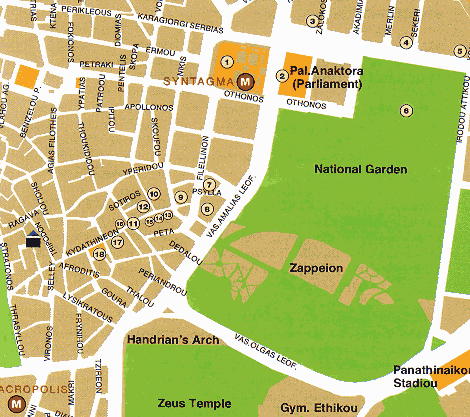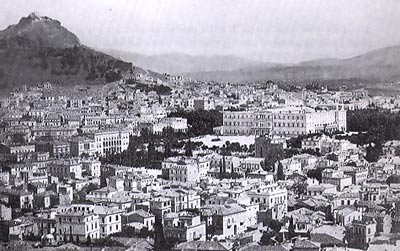|
(Continued from
July's Issue)
STARTING POINT:
Syntagma Station
TERMINUS:
Acropolis Station |
The 6th walk is
a journey through 19th
century Athens, the capital of the newly
formed independent Greek State. |
 (1)
SYNTAGMA SQUARE (CONSTITUTION SQUARE):
The most important square in Athens, named
so as to commemorate September 3, 1843, when
an Athenian revolt led by the military
forced King Otho to grant a constitution.
The 1843 constitution continued to consider
the monarch as the source of sovereignty but
gave the suffrage to the majority of the
male population of Greece. The 1864
constitution, after the exile of Otho and
the choice as King of George I, from
Denmark, transferred sovereignty from the
King to the people and instituted universal
male adult suffrage, long before most
countries in Europe.
Excavations unprecedented in extent took
place here in recent years due to the
construction of the Metro. The land was
found to have been inhabited since the
Sub-Mycenaean period (12th century BC) and
until Ottoman times, but had been on the
outer side both of the Diochares Gate, of
the classical Themistocleian Wall, and of
the Ottoman walls built by Haseki in 1778.
Inside Syntagma Station, one can see now a
representation of consecutive surfaces
chronicling the history of the area; the
lowest surface corresponds to the 5th
century BC, and the highest to the 19th
century.
(1)
SYNTAGMA SQUARE (CONSTITUTION SQUARE):
The most important square in Athens, named
so as to commemorate September 3, 1843, when
an Athenian revolt led by the military
forced King Otho to grant a constitution.
The 1843 constitution continued to consider
the monarch as the source of sovereignty but
gave the suffrage to the majority of the
male population of Greece. The 1864
constitution, after the exile of Otho and
the choice as King of George I, from
Denmark, transferred sovereignty from the
King to the people and instituted universal
male adult suffrage, long before most
countries in Europe.
Excavations unprecedented in extent took
place here in recent years due to the
construction of the Metro. The land was
found to have been inhabited since the
Sub-Mycenaean period (12th century BC) and
until Ottoman times, but had been on the
outer side both of the Diochares Gate, of
the classical Themistocleian Wall, and of
the Ottoman walls built by Haseki in 1778.
Inside Syntagma Station, one can see now a
representation of consecutive surfaces
chronicling the history of the area; the
lowest surface corresponds to the 5th
century BC, and the highest to the 19th
century.
The riverbed of the Iridanos and the wide
ancient street, that started from the Gate
of Diochares Gate and led to Mesogaia, were
also traced in the same area. The street was
found to have been paved some 30 times, and
there are visible traces of wheels on some
of the earthen surfaces. Tombs were found on
both sides of the street. Special mention
should be made of two burials of dogs and
one common burial of a horse and a dog. In
one of the animal burials, two glass perfume
cruets (1st or 2nd century AD) and a
wonderfully crafted collar were found, grave
offerings very similar to those found in
human graves.
Some of the findings, mostly vessels dating
from various periods, are now displayed
underground, on the station premises.
Additional findings include sections of an
aqueduct of outstanding craftsmanship, that
known as the "Peisistrateion" which actually
dates from the first half of the 5th century
BC.
After the invasion of the Herules (267 AD),
a large part of today's square was occupied
by a huge bath complex, which was later
destroyed, probably by the Goths under
Alaric (396 AD), and reconstructed in the
5th century AD.
(2)
THE PARLIAMENT BUILDING: The building
that now houses the Greek Parliament was
built in 1836-1843 by the Bavarian architect
Fr. Goertner as a royal palace. It continued
in this use until 1909, when it was partly
damaged by fire. Since 1932 it is the seat
of the Greek Parliament. The Monument to the
Unknown Soldier of 1932, now the focal point
of all national celebrations, was designed
by the architect Adrianos Lazaridis and the
sculptors Phokion Roek and Constantinos
Dimitriadis (the "Parisian"). (tel.: 210
3707000)
(3)
EGYPTIAN EMBASSY: The former residence
of Georgios Psyhas, an elegant neoclassical
mansion built in 1875 by the architect
Ernest Ziller. (3 Vasilissis Sofias Ave,
tel.: 210 3618612)
(4)
ITALIAN EMBASSY: Built in 1885 by the
architect Ernest Ziller, appointed by the
merchant Stephanos Psyhas. Later, it became
the residence of Prince Nicholas, son of
King George. In 1935 it was purchased by the
Italian State, and has since been the seat
of the Italian Embassy. (2 Sekeri St, tel.:
210 3617260)
(5)
FRENCH EMBASSY: Built in the early 20th
century by the architect Anastasios Metaxas.
Former residence of the Carolos Merlin
family. The French Embassy has been housed
here since 1914-15. (7 Vasilissis Sofias
Ave, tel.: 210 3391000-21)
(6)
NATIONAL GARDEN: Originally, and until
1922, this was the Royal Garden, open to the
public for limited hours only. A smaller
piece of land was first planted in the 1840s
by the Bavarian agronomist Schmidt. In the
1850s, the garden was expanded to its
current size: the whole area was marked out
and new trees were planted in accordance
with the English gardening style, which
favored rich vegetation. It is considered a
botanical garden of, mostly, Greek flora,
including: "tixilitha" (densely planted
pine trees from Sounio); "boreana variabilis"
from Mount Parnitha; "sacred" palm trees
from Delos, etc. Some 15,000 roots of noble
trees were sent here from Genoa. The
palm-trees inside the entrance of the garden
were sent here by the Regent of Egypt. Roses
and Granada seeds, a gift from the King of
Spain, were planted all over the garden.
According to the French romantic poet Ernest
Renan, "A stroll in this garden is the most
beautiful and glorious stroll in the
world...". (1 Vasilissis Amalias Ave, tel.:
210 7211178)
(7)
CHURCH OF SOTEIRA LYCODEMOS (now the RUSSIAN
CHURCH): It dates to the first half of
the 11th century. The founder was a man
named Stephanos, clearly a member of the
local Lycodemos family. It is an octagonal
church, a much larger structure compared to
the other churches of Athens, bearing
splendid Byzantine decoration on the outer
walls. It is a copy of the Katholikon, or
central monastic church, of Osios Loukas in
Boeotia. During Ottoman rule it belonged to
a monastery that was destroyed by an
earthquake in 1701.
The Russians bought the church in 1847,
restored it in 1855, and added a bell tower.
It was painted by the Bavarian painter
Ludwig Thiersch and the Greek painter
Nikiforos Lytras.
(21 Filellinon St, tel.: 210 3231090)
(8)
ANGLICAN CHURCH OF ST. PAUL: Its
construction began in 1838 to plans by H. Acland in a neo - gothic style. Some
alterations were made by C.R. Cockerell and
Ch. Hansen.
(Filellinon St)
(9)
JEWISH MUSEUM: A Historical and Folk
Museum that presents the social, religious
and cultural activities of the Jewish
community in Greece since 300 BC. There are
moving records of World War II; when,
fortunately, the majority of Athenian Jews
managed to escape the Nazi genocide, but the
Jewish communities in Greece as a whole were
tragically decimated. (39 Nikis St, tel.:
210 3225582)
(10)
GREEK MUSEUM FOR CHILDREN'S ART:
Founded in 1994. The museum aims at the
aesthetic education and promotion of
creativity in children, by introducing them
to all forms of art and helping them
appreciate it. It displays paintings and
artistic structures by children from the
ages of four to fourteen. (9 Kodrou St,
tel.: 210 3312750)
(11)
KYDATHINEON ST: Named after the "Kydathineon",
an aristocratic deme of ancient Athens. In
medieval times it was known as «Platea
rouga tou Aligomou».
 (12)
CHURCH OF AGHIA SOTEIRA OF COTTAKIS: A
four-columned cross-in-square church, built
in the second half of the 11th century,
probably on the ruins of an earlier church.
An extension in 1908 altered the appearance
of the building. According to the Greek
historian Kambouroglou, it was originally
dedicated to Panaghia the Soteira; instead,
it now celebrates its patrional feast on the
day of the Transfiguration of the Saviour.
(12)
CHURCH OF AGHIA SOTEIRA OF COTTAKIS: A
four-columned cross-in-square church, built
in the second half of the 11th century,
probably on the ruins of an earlier church.
An extension in 1908 altered the appearance
of the building. According to the Greek
historian Kambouroglou, it was originally
dedicated to Panaghia the Soteira; instead,
it now celebrates its patrional feast on the
day of the Transfiguration of the Saviour.
(13)
SEFERIADIS-TSATSOS HOUSE: For a short
time the residence of the diplomat and poet
George Seferis, the 1963 Nobel Prize winner
for literature, and until the end of their
lives of Constantinos Tsatsos, philosopher
and former President of the Republic of
Greece (1975-1980), and his wife Joanna, who
was Geoge Seferis' sister. (9 Kydathineon
St)
(14)
CENTRE FOR ASIA MINOR STUDIES:
Dedicated to the recording and preservation
of the culture of the Greek Communities in
the Asia Minor prior to 1922. It is housed
in one of the first buildings that were
built in the city shortly after its
liberation from the Ottomans.
(15) MUSEUM OF GREEK FOLK ART: It displays a
broad range of Modern Greek folk art,
illustrating clearly the forming of the
Modern Greek cultural identity from the mid
17th to the early 20th centuries. It exhibits
embroideries, metalwork, ceramic art, wood
sculptures, silverwork, costumes, etc. Ofparticular interest is the room exhibiting
the wall paintings from a house in Lesvos,
the work of the popular painter Theofilos
Hatzimichael (1860-1934). (17 Kydathineon
St, tel.: 210 3229031)
(16)
GREEK CHILDREN'S MUSEUM: For children
under 12, their parents, and teachers. It
was founded in 1994, with the collaboration
of the Municipality of Athens. It is housed
in a neoclassical building that dates from
c.1900. (14 Kydathineon St, tel.: 210
3312995-7)
(17)
IOANNIS PAPARRIGOPOULOS MANSION:
(27 Kydathineon St)
(18)
FILOMOUSOU ETAIRIAS SQUARE: Named after
the Filomousos Etairia, originally founded
as the former "Athenian Library", in 1813.
It's objectives were of a social, cultural
and national.
-
TRIPODON ST
-
ELLINIKI ETAIRIA
-
LYSICRATES' MONUMENT
-
ACROPOLIS STATION (M)
|
 |
To read about these 4
locations, please refer to our March
newsletter featuring
Heritage Walk #1 |

